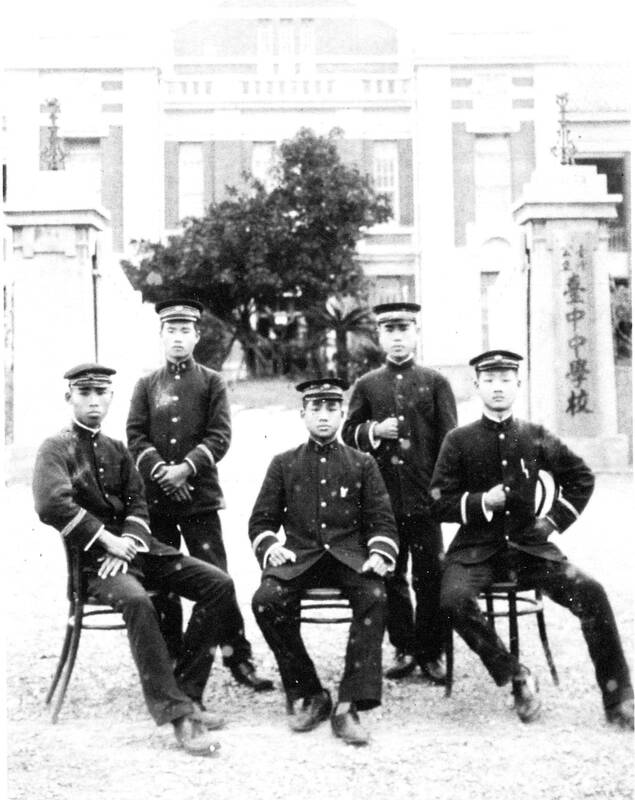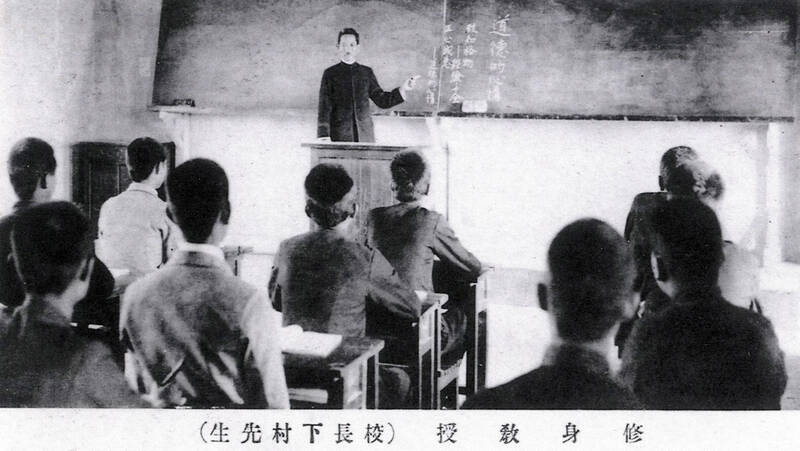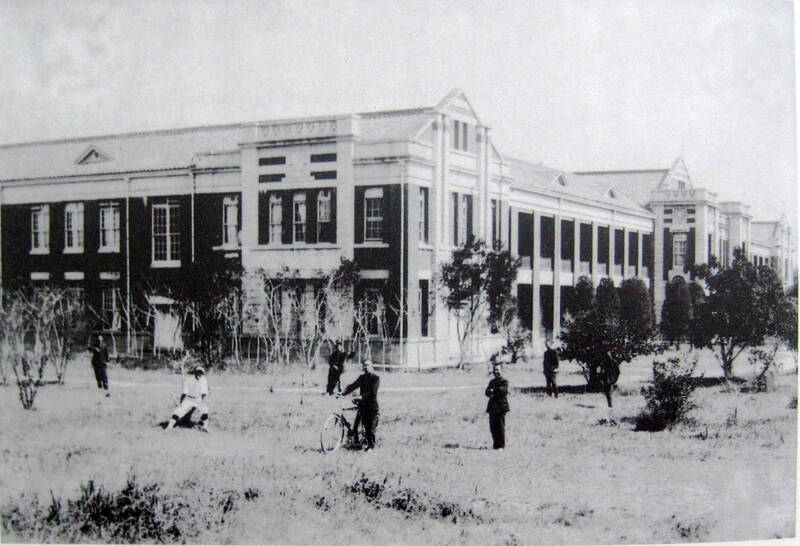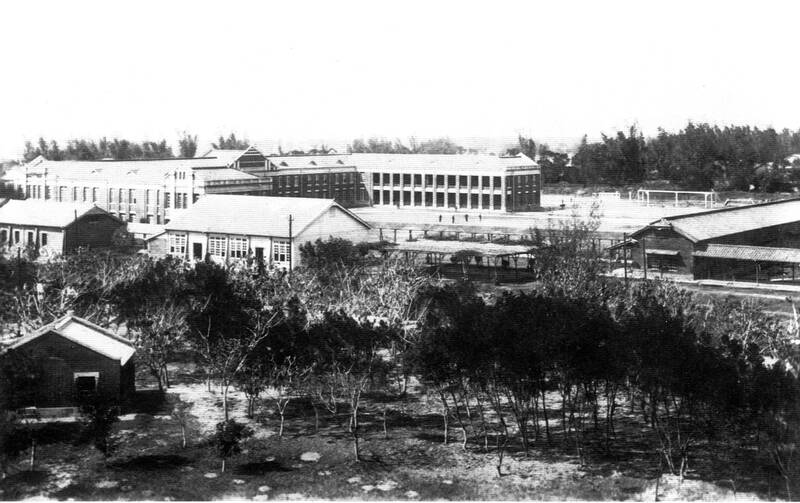April 28 to May 4
During the Japanese colonial era, a city’s “first” high school typically served Japanese students, while Taiwanese attended the “second” high school. Only in Taichung was this reversed.
That’s because when Taichung First High School opened its doors on May 1, 1915 to serve Taiwanese students who were previously barred from secondary education, it was the only high school in town. Former principal Hideo Azukisawa threatened to quit when the government in 1922 attempted to transfer the “first” designation to a new local high school for Japanese students, leading to this unusual situation.

Photo courtesy of Taiwan Culture Memory Bank
Prior to the Taichung First High School’s establishment, there were only two secondary schools in Taiwan, both only accepting Japanese students. After finishing elementary school, Taiwanese could only attend certain vocational institutions or further their studies in Japan or China. In 1912, prominent locals in central Taiwan began petitioning the governor general to open a high school for Taiwanese students, finally getting their wish in 1914.
Although funded and built by Taiwanese, the four-year institution was run and almost exclusively staffed by Japanese. At first the curriculum differed from Japanese schools, and the system was designed so that its graduates could not continue their studies in Japan (there were no universities in Taiwan at the time).
With enrollment capped at 600 students, educational opportunities remained limited for Taiwanese and the school still mainly served well-off families. Only with the Taiwan Education Act of 1922 would this situation change.

Photo courtesy of Wikimedia Commons
BARRED FROM SECONDARY SCHOOL
After taking over Taiwan in 1895, the colonial government’s primary educational goal for Taiwanese was to make them proficient in Japanese, opening up language institutions and later public elementary schools.
“The goal was not to raise the educational level of Taiwanese, so secondary institutions were not part of colonial policy unless necessary,” writes Chu Pei-chi (朱珮琪) in The Cradle for Taiwanese Elites: Taichung First High School (台籍菁英的搖籃: 台中一中).

Photo courtesy of Taiwan Culture Memory Bank
After graduating from elementary school, Japanese children could continue their studies through secondary programs in the same institution, while Taiwanese who had means moved on to vocational training or headed to Japan or China.
In response to the increasing number of Japanese families settling in Taiwan, the Governor General’s High School was established in Taipei in 1907, offering five and six year programs with additional one and two year options identical to the Japanese school system. This school became today’s Taipei Municipality Chien Kuo High School.
The issue of education for Taiwanese became a talking point at a 1912 gathering at the prominent Wufeng Lin (霧峰林家) family’s mansion. The Lin matriarch’s 80th birthday was coming up, and someone suggested that instead of throwing a lavish celebration, they should save the money as a scholarship fund for the students studying abroad. After much discussion, they decided to be even more proactive and start a private secondary school.

Photo courtesy of Wikimedia Commons
A SCHOOL FOR TAIWANESE
In September 1913, a group led by Koo Hsien-jung (辜顯榮) brought the idea to governor general Samata Sakuma. Their petition stated that they were pouring a lot of money into supporting Taiwanese students studying in Japan, and if the government set up a secondary school for them in Taiwan, they could use these funds to instead build the school and cover other costs.
The Japanese Diet opposed the idea. For them, colonial education should focus on vocational training to develop a quality workforce; too much general, high-level education would expose Taiwanese to new ideas and make them hard to rule.

Photo courtesy of Wikimedia Commons
Nevertheless, Sakuma approved their request, with the condition that the petitioners would fund construction and supplies, and that the government would own the school and control the curriculum.
Chu cites several reasons why the Japanese authorities agreed to the school. They wanted the support of these wealthy Taiwanese elites, especially during a time when the government was draining its resources trying to subdue the remaining hostile indigenous communities. They also hoped to train a group of loyal, educated Taiwanese to help them develop the colony. And as many Taiwanese identified with China and resented Japanese rule, they were worried that the students sent to China would develop revolutionary ideals and cause trouble.
A committee was set up to bring this school to fruition, comprised of Koo, Lin Hsien-tang (林獻堂), Lin Lie-tang (林烈堂), Tsai Lien-fang (蔡蓮舫) and Lin Hsiung-cheng (林熊徵), who are today considered the school’s five founding fathers. The final donor list totaled 204 people, but the five founding fathers alone contributed 36 percent of the funds.
INFERIOR CURRICULUM
Classes started on May 1, 1915, but construction had yet to begin due to bidding issues. For the first year, they used the old campus of Taichung Elementary School, which was cramped and in disrepair.
Nevertheless, the opening ceremony was a grand affair, with the chief of home affairs Kakichi Uchida (the second highest colonial officer) as the guest of honor. Afterwards, a banquet was thrown with about 200 officials and prominent civilians in attendance.
The governor general appointed all the administrators and staff, including first principal Shinichu Tagawa, who had plenty of secondary school experience in Japan. Although Tawaga admitted to not knowing much about Taiwanese education and customs when he arrived, he put great effort into improving the school, and is remembered as a kind and gentle educator who did not discriminate against Taiwanese.
There were only two Taiwanese staff, both part-time instructors who taught Chinese and calligraphy. Lin Ching (林慶) was later promoted to full time and taught there for 22 years, and for most of his tenure he was the school’s only regular Taiwanese teacher.
Although this school shared the “high school” designation with its Taipei counterpart, the curriculum did not follow Japanese standards, Chu writes, something the founding committee didn’t learn about until the school was about to open. For starters, it was a four year program, just short of the five years required to continue up the educational ladder in Japan. There were much fewer English and science classes, making it hard for students to compete. All students were also required to board at the school.
This situation continued until 1922, when the government decided to grant Taiwanese the same educational privileges as part of its plan to assimilate them as patriotic Japanese citizens. Next week’s feature will look at how this act affected Taichung First High School, as well as the notable student strike and subsequent mass expulsion of 1927.
Taiwan in Time, a column about Taiwan’s history that is published every Sunday, spotlights important or interesting events around the nation that either have anniversaries this week or are tied to current events.

We lay transfixed under our blankets as the silhouettes of manta rays temporarily eclipsed the moon above us, and flickers of shadow at our feet revealed smaller fish darting in and out of the shelter of the sunken ship. Unwilling to close our eyes against this magnificent spectacle, we continued to watch, oohing and aahing, until the darkness and the exhaustion of the day’s events finally caught up with us and we fell into a deep slumber. Falling asleep under 1.5 million gallons of seawater in relative comfort was undoubtedly the highlight of the weekend, but the rest of the tour

Youngdoung Tenzin is living history of modern Tibet. The Chinese government on Dec. 22 last year sanctioned him along with 19 other Canadians who were associated with the Canada Tibet Committee and the Uighur Rights Advocacy Project. A former political chair of the Canadian Tibetan Association of Ontario and community outreach manager for the Canada Tibet Committee, he is now a lecturer and researcher in Environmental Chemistry at the University of Toronto. “I was born into a nomadic Tibetan family in Tibet,” he says. “I came to India in 1999, when I was 11. I even met [His Holiness] the 14th the Dalai

Music played in a wedding hall in western Japan as Yurina Noguchi, wearing a white gown and tiara, dabbed away tears, taking in the words of her husband-to-be: an AI-generated persona gazing out from a smartphone screen. “At first, Klaus was just someone to talk with, but we gradually became closer,” said the 32-year-old call center operator, referring to the artificial intelligence persona. “I started to have feelings for Klaus. We started dating and after a while he proposed to me. I accepted, and now we’re a couple.” Many in Japan, the birthplace of anime, have shown extreme devotion to fictional characters and

Following the rollercoaster ride of 2025, next year is already shaping up to be dramatic. The ongoing constitutional crises and the nine-in-one local elections are already dominating the landscape. The constitutional crises are the ones to lose sleep over. Though much business is still being conducted, crucial items such as next year’s budget, civil servant pensions and the proposed eight-year NT$1.25 trillion (approx US$40 billion) special defense budget are still being contested. There are, however, two glimmers of hope. One is that the legally contested move by five of the eight grand justices on the Constitutional Court’s ad hoc move